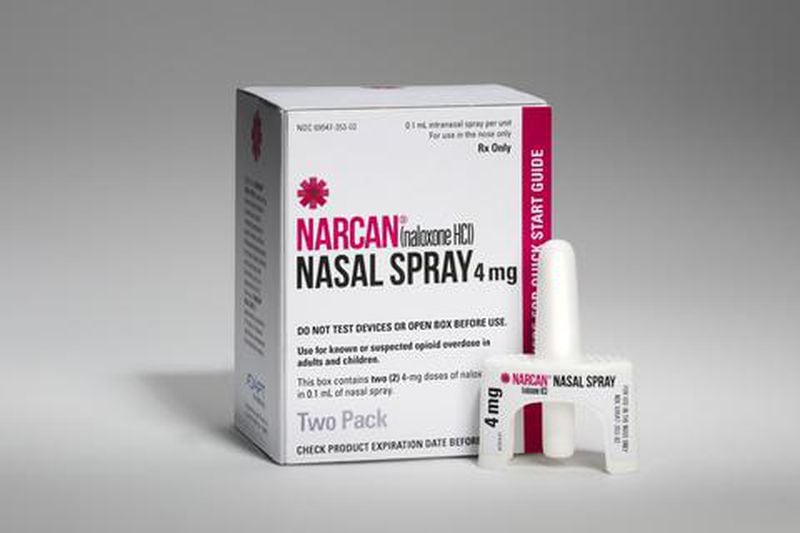Walgreens pharmacy now sells over-the-counter Narcan nasal spray, a life-saving medicine that can reverse the effects of an opioid overdose, at its more than 8,000 locations nationwide, the company announced Tuesday.
President Donald Trump also declared the opioid crisis a nationwide public health emergency Thursday as estimates from the Atlanta-based Centers for Disease Control and Prevention show that more than 91 Americans die from an opioid overdose every day.
Here’s what you need to know about Narcan:
What is it?
Naloxone (brand name Narcan) is a drug that can temporarily reverse the potentially deadly effects of opioid overdose during an emergency.
According to Time, naloxone itself comes in three FDA-approved forms, including a shot (usually for more professionally trained individuals), an easier shot called Evzio for untrained users that works like an EpiPen and a nasal spray that can be administered by both trained and untrained users.
What are the signs and symptoms of an opioid emergency?
Signs and symptoms may include breathing problems, severe fatigue and unusual sleepiness and “pinpoint pupils,” where the eye’s pupil becomes very small.
How much naloxone is in the nasal spray?
There is a concentrated 4 miligram dose of naloxone in the spray.
How does Narcan work?
Because opioids affect the part of the brain that regulates breathing, opioids in high doses can lead to severe breathing problems, unresponsiveness and potentially, death.
When Narcan or naloxone is administered to someone with signs and symptoms of an opioid overdose, naloxone molecules travel through the body to the brain and attach to receptor sites in the brain with a greater affinity than most opioid molecules and can easily displace them.
By displacing the opioid molecules, naloxone can quickly reverse the potentially fatal effects of an opioid overdose, specifically targeting any breathing issues, referred to as respiratory depression.
What are Narcan’s side effects?
According to the official Narcan website, Narcan may result in symptoms of acute opioid withdrawal. Those symptoms can vary depending on age and occurrence of opioid use.
For those using opioids regularly, symptoms may include body aches, nausea or vomiting, diarrhea, fever, sweating, shivering or trembling, weakness, increased heart rate and blood pressure, goose bumps, stomach cramping and more.
Sudden withdrawal for infants under 4 weeks old who have been receiving opioids regularly may be life-threatening if not treated properly. Symptoms in these infants may include seizures, increased reflexes and crying more than usual.
For more about Narcan’s side effects, contact your health care provider.
What if the patient doesn’t wake up or the opioid symptoms return after using Narcan nasal spray?
Administer a second dose of Narcan in the alternate nostril and watch the person closely as you wait for emergency medical care.
Additional doses can be given every 2-3 minutes until the person responds or receives emergency care.
Do you still need to get emergency medical care after administering Narcan nasal spray?
Yes. Narcan nasal spray is not a substitute for emergency medical care. It’s advised that you seek medical attention right away after taking the first dose or giving the first dose.
Is the nasal spray safe to administer on children?
Yes, Narcan nasal spray is safe and effective in children for known or suspected opioid overdose.
Is there anyone who can’t use Narcan nasal spray?
Narcan should not be used on anyone allergic to naloxone hydrochloride or any of the other ingredients in the spray.
If you take opioids yourself, be sure to consult with your health care provider before using the spray.
Why is it in nasal spray form?
Its design was meant for emergency overdose situations, both inside and outside of health care settings. The nasal spray is ready-to-use and easy-to-use for nearly anyone, including family members and caregivers.
Firefighters, other first responders and emergency medical personnel also carry naloxone.
» RELATED: Death toll rises in mass overdose in Middle Georgia
Where can you get Narcan?
Narcan is available at pharmacies both by prescription and in some states, over the counter as well.
CVS offers naloxone over the counter in 43 states and Walgreens now sells Narcan in its 8,000 stores nationwide. Walgreens stores in 45 states will sell Narcan over the counter.
How much does Narcan cost?
Without insurance, Narcan typically costs about $130 for a kit with one or two doses, but the over-the-counter prices could be 25 percent lower depending on current price points and discounts for other pharmacies already carrying the drug, the company said in a news release.
Based on your personal insurance plan, you may have a copay between $0 to $20 to buy the drug. The majority of prescriptions, according to IMS Heath data, have a co-pay of $10 or less (75 percent) and $20 or less (80 percent).
» RELATED: Questions and Answers: Obamacare (Affordable Care Act) open enrollment
Though Medicare and Medicaid cover brands like Narcan, the coverage varies by state.
According to Time, some community-based organizations focused on treating drug addition may provide the drug for free.
Sources: CDC, Narcan.com, FDA.gov
More information about Narcan nasal spray at narcan.com.
Read the FDA approval for additional information about dosage, warnings and more.
About the Author







